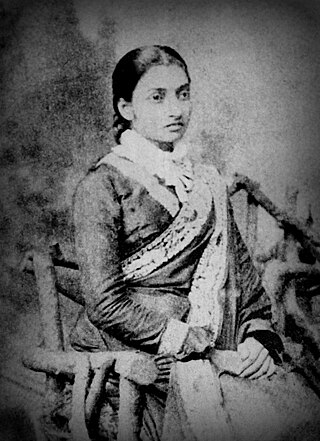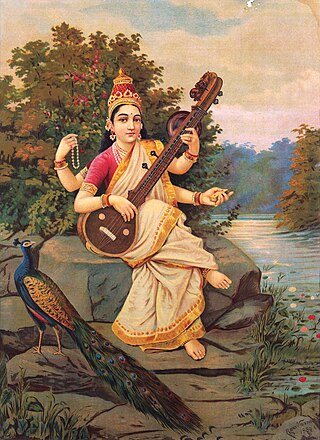
A sari is a women's garment from the Indian subcontinent. It consists of an un-stitched stretch of woven fabric arranged over the body as a robe, with one end attached to the waist, while the other end rests over one shoulder as a stole, sometimes baring a part of the midriff. It may vary from 4.1 to 8.2 metres in length, and 60 to 120 centimetres in breadth, and is a form of ethnic wear in Bangladesh, India, Sri Lanka, Nepal, and Pakistan. There are various names and styles of sari manufacture and draping, the most common being the Nivi style. The sari is worn with a fitted bodice also called a choli and a petticoat called ghagra, parkar, or ul-pavadai. It remains fashionable in the Indian subcontinent today.

Singh is a title, middle name, or surname that means "lion" in various South Asian and Southeast Asian communities. Traditionally used by the Hindu Kshatriya community, it was later mandated in the late 17th century by Guru Gobind Singh for all male Sikhs as well, in part as a rejection of caste-based prejudice and to emulate Rajput naming conventions. As a surname or a middle name, it is now found throughout the world across communities and religious groups, becoming more of a generic, caste-neutral, decorative name—similar to names such as Kumar and Lal.
Clothing in India varies with the different ethnicities, geography, climate, and cultural traditions of the people of each region of India. Historically, clothing has evolved from simple garments like kaupina, langota, achkan, lungi, sari, to perform rituals and dances. In urban areas, western clothing is common and uniformly worn by people of all social levels. India also has a great diversity in terms of weaves, fibers, colors, and the material of clothing. Sometimes, color codes are followed in clothing based on the religion and ritual concerned. The clothing in India also encompasses a wide variety of Indian embroidery, prints, handwork, embellishments, and styles of wearing clothes. A wide mix of Indian traditional clothing and western styles can be seen in India.

The Chakma people or Changhma people, are an ethnic group from the eastern-most regions of the Indian subcontinent and Western Myanmar. They are the second largest ethnic group of the Chittagong Hill Tracts region of southeastern Bangladesh, and the largest in the Chakma Autonomous District Council of Mizoram, India. Significant Chakma populations are found in the northeast Indian states of Arunachal Pradesh, Tripura and Assam.
Devanga is a Hindu caste from South India that traditionally followed the occupation of textile merchandise, weaving and farming mostly found in the Indian states of Karnataka, Kerala, Andhra Pradesh, Tamil Nadu and Odisha.

The Meghwal or Meghwar people live primarily in northwest India, with a small population in Pakistan. Their traditional occupation was agricultural farming, cattle-herding and weaving. Meghwals are known for their contribution to embroidery and the textile industry. Most are Hindu by religion, with Rishi Megh, Kabir, Ramdev Pir and Bankar Mataji as their chief gods.

The Balai, Raj Balai, BalahiBunkar, or Sutarkar are found in the states of Madhya Pradesh, Rajasthan, Punjab, Maharashtra, Delhi and Uttar Pradesh in India.

Vasant Panchami, also rendered Vasanta Panchami and Saraswati Puja in honour of the Hindu goddess Saraswati, is a festival that marks the preparation for the arrival of spring. The festival is celebrated in Indian religions in different ways depending on the region. Vasant Panchami also marks the start of preparation for Holika and Holi, which take place forty days later. The Vasant Utsava (festival) on Panchami is celebrated forty days before spring, because any season's transition period is 40 days, and after that, the season comes into full bloom.
Maya textiles (k’apak) are the clothing and other textile arts of the Maya peoples, indigenous peoples of the Yucatán Peninsula in Mexico, Guatemala, Honduras, El Salvador and Belize. Women have traditionally created textiles in Maya society, and textiles were a significant form of ancient Maya art and religious beliefs. They were considered a prestige good that would distinguish the commoners from the elite. According to Brumfiel, some of the earliest weaving found in Mesoamerica can date back to around 1000–800 BCE.
Ethnic minorities of Bangladesh or loosely termed minority people of Bangladesh are ethnic minorities in Chittagong Hill Tracts (southeastern), Sylhet Division (northeastern), Rajshahi Division (west), and Mymensingh Division (north-central) areas of the country. They are assumed as ethnic group and the tribal races, total population of ethnic minorities in Bangladesh was estimated to be over 2 million in 2010. They are diverse ethnic communities including Tibeto-Burman, Austric and Dravidian people.
Padmasali is a Hindu caste residing in the Indian states of Andhra Pradesh, Telangana, Karnataka, Maharashtra, Gujarat and Tamil Nadu. Their traditional occupation is weaving and clothes business.

Chura, chuda, or chudlo is a set of bangles traditionally worn by a bride on her wedding day and for a period after, especially in Indian weddings.

The Rowther are a distinct Muslim community living largely in the south Indian states of Tamil Nadu and Kerala. They are descent from the Turkic people who came to settle in chola kingdom for horse trade and cavalry and majorly people who converted to Islam by preacher Nathar Shah in the 10th to 11th century. Even after conversion they retained their Ravuttar caste name. They were elite cavalrymen of the Chola and Pandya kingdoms. They were traditionally a martial clan like the Maravars, and constitute large part of the multi-ethnic Tamil Muslim community. Rowthers have also been found as Tamil polygars, zamindars and chieftains from the 16th to 18th centuries. The traditional homelands of the Rowthers were in the interior of Southern Tamilakam.

The Tanchangya people, Tanchangyas or Tonchongyas are an Chinwin valley origin ethnic group living in the Chittagong Hill Tracts (CHT) of Bangladesh, Indian states of Tripura and Mizoram, and Rakhine state of Myanmar.
Thogata Veera Kshatriya are a Hindu community found in the Indian states of Andhra Pradesh, Telangana, Karnataka, Tamil Nadu, and Maharashtra. They claim descent from Chaudeswari and follow Vaishnavite tradition.
The Bizu festival is celebrated by the Chakma people in Bangladesh and India, as the traditional New Year's Day which falls on 13 or 14 April.

In the Punjab region, people wore cotton clothing. Both men and women wore knee-length tops. A scarf was worn over the tops which would be draped over the left shoulder and under the right. A large sheet would be further draped over one shoulder which would hang loose towards the knees. Both male and female wore a dhoti around the waist. Modern Punjabi dress has retained the dhoti, but over its long history has added other forms of dress.
The people of Jammu have the following traditional clothing:

The culture of the Mizo people has been heavily influenced by Christianity during the colonial era of the British Raj and the rise of Mizo nationalism with the Mizo Insurgency of 1966-1986. Mizo culture is rooted in the arts and ways of life of Mizos in India, Bangladesh and Myanmar. Mizo culture has developed in plurality with historical settlements and migrations starting from Southern China to the Shan states of Burma, the Kabaw valley and the state of Mizoram under the British and Indian administrations.

The 'Meitei Laining' is a term used to describe the original animistic religious belief system of the Meitei ethnicity in particular. It refers to the pre-Hindu faith of the Meitei ethnic group. It incorporates various teachings from the Meitei scriptures. Meitei Laining is a large facet of the collective synthesis of beliefs known as Sanamahism.













